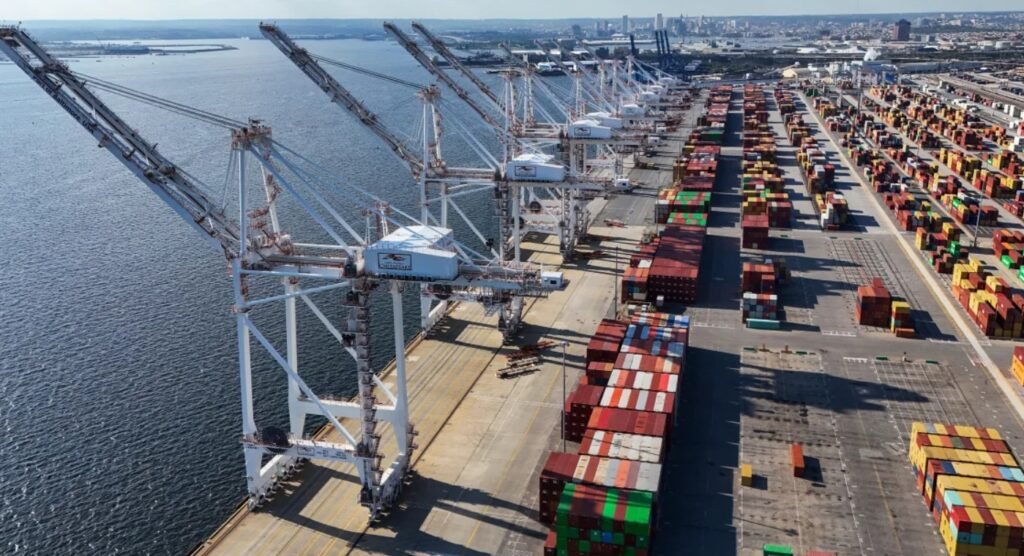what are the top 10 ports in the us? What is the annual container throughput and the total import and export volume? This guide will give you a comprehensive understanding
The United States, the world’s largest economy, continues to grow, even expanding by 5.7% during the Covid recession due to increased consumer spending. A key factor in this growth is the nation’s 360 shipping ports, which are equipped with advanced infrastructure and technology.
These ports are among the largest and busiest maritime gateways globally, handling vast volumes of shipments crucial to the economy.
Thus, we’ve put together the largest and busiest ports in the US that make the country’s—as well as the whole world’s— economy flourish.
What are the largest ports in the US
Top 10 largest and busiest ports in the US
The Port of Los Angeles, California
The Port of Los Angeles, located in San Pedro Bay, California, is one of the busiest ports globally and a key hub for cruise ships.
For over 20 years, it has led US ports in container cargo handling, managing over 9 million TEUs annually.
In 2023, it handled 8,634,497 TEUs and supported around 3 million jobs in the United States.
Spanning 7,500 acres, it includes 25 cargo terminals for various types of cargo and passenger terminals. The total number of imports is 5,015,315 and export is 4,895,844.
The port ranks 17th worldwide in container volume and handles 20% of US imports, with major trade partners including China, Japan, Vietnam, and South Korea.
The Port Of Long Beach, California
The Port of Long Beach, near the Port of Los Angeles in San Pedro Bay, is one of the busiest ports in the US and the 21st busiest container port globally.
In 2023, it handled 8,018,668 TEUs and it covers 8,120 acres. The port exports meat, groceries, and cotton, and imports beverages, seafood, and refrigerated food.
Total Imports through this port are 4,526,997 and exports are 4,606,660. Key for US-Asian trade, it follows the Green Port Policy, which reduces ship speeds to cut fuel use and air pollution.
With 22 terminals, including 6 container terminals, it serves 175 shipping lines and 217 major global ports, generating over $100 billion annually and employing over 300,000 people in California.
The Port Of New York And New Jersey
The Port of New Jersey and New York is the largest port in the U.S. East Coast, covering 1,500 square miles. It is a key hub for global trade, handling a wide variety of cargo including containers, petroleum, automobiles, and more.
In 2023, it processed 7.8 million TEUs. The number of imports at this port is 4,825,075 and export is 4,668,589.
The port features 6 container terminals that can service 9 large ships at once and has 386 kilometers of shipping channels and facilities. It mainly trades with China, India, Germany, Italy, and the Netherlands.
The Port Of Savannah, Georgia
The Port of Savannah is the 4th busiest port in the US and the largest single container terminal in North America. Covering 1,345 acres, it handles a wide range of goods including paper, electronics, and automobiles.
The overall volume of imports and exports through this port is 2,927,390 and 2,964,741 respectively.
In 2023, it managed 4.9 million TEUs and expects an increase with a capacity boost of 750,000 TEUs.
Operated by the Georgia Ports Authority, it has two main terminals: Garden City, the advanced container terminal, and Ocean, for RORO and breakbulk.
By 2035, the Jasper Ocean Terminal will be the largest in the US. The port is crucial for trade with Asia, Latin America, and Europe.
The Port of Houston, Texas
Houston Port in Texas is the busiest U.S. port for foreign waterborne tonnage and the largest in the Gulf of Mexico, spanning 80 km.
It supports economic growth with 1.35 million jobs in Texas and 3.2 million nationwide, generating over $265 billion in annual revenue.
In 2023, it handled 3,824,600 TEUs.
The port features two container terminals and the country’s largest petrochemical facility. Key exports include petroleum, minerals, oils, plastics, wood, and fertilizers, while imports include palm oil, milk, wine, kerosene, and ethanol.
The Bayport Container Terminal is notably advanced, serving trade with Europe, APEC, Africa, and the Middle East.
The Port Of Virginia, Virginia
The Port of Virginia is situated on the eastern coast, and this makes it directly accessible to the Atlantic Ocean, which is suitable for big container ships.
Spread over 1,864 acres, it moved 3. 4 million TEUs in 2023 and contributes to over 397, 000 jobs. The cumulative figure for imports and exports via this port is 1,768,850 and 1,045,765.
It has four marine terminals, deep water channels, and modern facilities to handle the cargo and provide fast vessel turnaround.
Its supply chain is strengthened by good relations with the shipping companies and logistics providers. It exports machinery, furniture, oil while it imports grains, fruits and wood.
The Port Of Seattle and Tacoma, Washington
The creation of the Northwest Seaport Alliance in 2015 through the merger of the ports of Seattle and Tacoma consolidates the Puget Sound entrance and increases throughput.
Based in the Pacific Northwest, it links to Asia and deals with various types of cargo such as containers, breakbulk, and automobiles. As one of the biggest container ports in North America it handled 3 million TEUs in the year 2023, a 12%.
It has also reduced its budget by 1% than what it allocated in the previous year. The total quantity of imports and exports of this port is 1,258,631 and 555,556.
It occupies 1,754 acres and provides 58,000 jobs and more than $4. 3 billion in economic activity per annum with the advanced terminals for the large container ships.
The Port Of Charleston, South Carolina
The Port of Charleston in South Carolina is the 8th largest container port in the U. S. and has a throughput of 2. 6 million TEU in the year 2023.
It occupies 700 acres of land and handles all types of cargoes and provides employment to more than 187000 people and contributes over $17 billion to the economy.
The total flow of imports and exports through this port amounts to 1,411,993 and 716,540.
It has modern terminals such as the Wando Welch Terminal and the newly established Hugh K. Leatherman Terminal.
Charleston Port is an efficient and environmentally conscious port, which is important for international commerce and economic development.
The Port Of Oakland, California
The Port of Oakland occupies 1300 acres and is the 9th largest container port in the United States, and it deals with approximately 2065709 TEUs in the year 2023.
Sited on the eastern shore of San Francisco Bay, it is strategic for commerce with Asia and export products such as farm produce, technology, and wine.
The total amount of goods entering and leaving this port is 990,820 and 760,796. It has 2 container terminals and 27 cranes;
it is growing to handle larger ships and construct a new railway yard. It also has a truck management program to control emission and is among the best ports on the Pacific Coast for containerized cargo.
The Port of Miami, Florida
The Port of Miami occupies 520 acres and is the 10th largest in the US with more than 1 million TEUs in 2023. It is also the largest cruise port in the world with over 5 million passengers’ traffic per year.
It is a major trade gateway to the Caribbean and Latin America and primarily deals in containerized cargo, automobiles and machinery.
It generates over $41 billion in revenue and supports more than 300,000 employees; the PortMiami Tunnel to facilitate the movement of cargo is included and the main channel has been dredged to accommodate large vessels.
How many ports are there in the USA?
The United States has about 150 ports on the East Coast and around 90 ports on the West Coast. These figures include both major and smaller ports used for commercial activities.
Other ports may not handle the same volume as the top ten, but they are vital to the communities they serve and the industries they support. Here are few of them:
Smaller but Significant Ports
- Port of Tampa Bay, Florida
The largest port in Florida, Port of Tampa Bay handles diverse cargo, including bulk and containerized goods. It also supports the cruise industry, making it a key economic player in the state.
- Port of Richmond, California
Located in the San Francisco Bay Area, the Port of Richmond specializes in bulk commodities like petroleum, automobiles, and bulk cargo. Its strategic position makes it vital for regional imports and exports.
- Port of Corpus Christi, Texas
A major U.S. energy port, Corpus Christi handles large volumes of crude oil, petroleum products, and LNG. The port is expanding to accommodate more cargo and larger vessels.
Ports Serving Specific Industries
- Port of Anchorage, Alaska
The Port of Anchorage is the main point where most goods are imported into the state and includes food, fuel, and construction materials.
- Port of New Haven, Connecticut
Primarily an importer of petroleum products, the port of New Haven is among the most active in New England; it also handles steel, salt, and other bulk shipments.
- Port of Toledo, Ohio
The Port of Toledo is situated at the southern shore of Lake Erie and deals with coal, grain and iron ore imports as it is among the most important bulk cargo ports in the Great Lakes.
America’s Busiest Port’s Impact on the U.S
The busiest seaports are crucial to global commerce, driving national economies and international trade. Let’s explore the impact of the US busiest port’s pivotal role and impact on the maritime industry.
- Economic Impact
The Port of Los Angeles is one of the most important centres of commerce. Every year it processes millions of shipping containers which bring items such as electronics, apparel, and machinery into the United States. The Port is responsible for over 3M jobs in the whole of the US.
- Supply Chain
The port is an important element of the global production chain, which links the US with Asian and other markets. It deals with a wide variety of goods such as electronics, apparels, machinery and vehicles. The capacity of the Port of Los Angeles and its effectiveness in terms of costs, thus, guarantee the constant supply of goods across the territory.
- Infrastructure and Development
The port of Los Angeles has triggered a lot of investment in infrastructure. There are road and railway networks together with highways that have either been constructed or reconstructed to facilitate the operations of the port. These structures also serve not only for the benefit of the port but also for other industries and other people of the region.
- Environmental Considerations
The large ports have an environmental impact. The Port of Los Angeles is committed to the reduction of pollution and the preservation of the environment. Measures include switching to cleaner fuel, and increasing the efficiency of energy usage, as well as regular checking of air and water pollution.
- National Security
The port plays a role in national security. It is an important strategic center for the reception of military supplies and equipment. Also, the port works together with the government agencies in matters concerning safety of imported products and other requirements.
A Guide to China’s Top 5 Airports 2025
Soaring Through the Middle Kingdom: A Guide to China’s Top 5 Airports 2025, China’s meteoric…
The Ultimate Guide to Sourcing & Shipping Christmas Ornaments from China
The Ultimate Guide to Sourcing & Shipping Christmas Ornaments from China. The holiday season is…
Decoding Shunde: The Ultimate Guide to the World’s Appliance Capital
Decoding Shunde, If you’ve ever turned on a microwave, blended a smoothie, or adjusted your…






